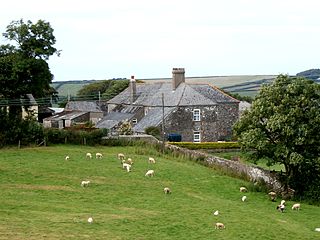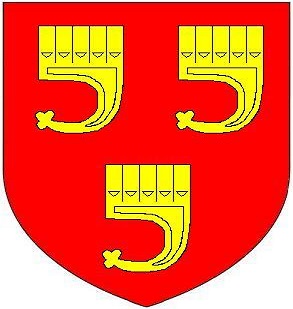
Modbury is a large village, ecclesiastical parish, civil parish and former manor situated in the South Hams district of the county of Devon in England. Today due to its large size it is generally referred to as a "town" although the parish council has not elected to give itself the status of a town as it could do under s.245(6) of the Local Government Act 1972, so it does not have a town council and cannot have a town mayor. It is also known informally as a "market town", as from at least 1199 the lord of the manor has held the right to hold a regular market. The village is situated on the A379 road, which links it to Plymouth and Kingsbridge. The current parish population is approximately 1,500.
Reginald de Dunstanville was an Anglo-Norman nobleman and an illegitimate son of King Henry I (1100–1135). He became Earl of Cornwall and High Sheriff of Devon.

Trerice is an historic manor in the parish of Newlyn East, near Newquay, Cornwall, United Kingdom. The surviving Tudor manor house known as Trerice House is located at Kestle Mill, three miles east of Newquay. The house with its surrounding garden has been owned by the National Trust since 1953 and is open to the public. The house is a Grade I listed building. The two stone lions on the front lawn are separately listed, Grade II. The garden features an orchard with old varieties of fruit trees.

Umberleigh is a former large manor within the historic hundred of (North) Tawton, but today a small village in North Devon in England. It used to be an ecclesiastical parish, but following the building of the church at Atherington it became a part of that parish. It forms however a part of the civil parish of Chittlehampton, which is mostly located on the east side of the River Taw.

Condor was reported by William of Worcester and later antiquaries to have been earl of Cornwall at the time of the Norman Conquest of England in 1066, and paid homage to William the Conqueror to keep his position. William Hals speculated that he may have supported the rebels at the Siege of Exeter (1068) and lost his earldom; much of Cornwall was given to William's Norman supporters soon afterwards. Condor's son Cadoc may have regained the title under Henry I, and later passed it through his daughter to Reginald de Dunstanville.

Halsbury is a historic manor in the parish of Parkham in North Devon, England. It is situated 2 miles north-east of the village of Parkham and 4 miles south-west of the town of Bideford. Halsbury was long a seat of the ancient Giffard family, a distant descendant of which was the celebrated lawyer Hardinge Stanley Giffard, 1st Earl of Halsbury (1823–1921), who adopted the name Halsbury for his earldom and was the author of the essential legal reference books Halsbury's Statutes. Halsbury Barton, now a farmhouse, retains 16th- and 17th-century elements of the former manor house of the Giffard family. It was described in a record of 1560 as a "new dwelling house".

Robert Willoughby, 1st Baron Willoughby de Broke, de jure 9th Baron Latimer, KG, of Brook, Westbury, Wiltshire, was one of the chief commanders of the royal forces of King Henry VII against the Cornish Rebellion of 1497.

Sir Richard Edgcumbe of Cotehele in the parish of Calstock in Cornwall, was an English courtier and Member of Parliament.

Sir Philip Courtenay of Powderham, Devon, was the senior member of a junior branch of the powerful Courtenay family, Earls of Devon.

Members of the Basset family were amongst the early Norman settlers in the Kingdom of England. It is currently one of the few ancient Norman families who has survived through the centuries in the paternal line. They originated at Montreuil-au-Houlme in the Duchy of Normandy.

Sir Hugh Courtenayof Boconnoc, Cornwall, was MP for Cornwall in 1446-47 and 1449-50. He was beheaded after the Battle of Tewkesbury in 1471.
The Feudal Barony of Berry Pomeroy was one of eight feudal baronies in Devonshire which existed during the mediaeval era, and had its caput at the manor of Berry Pomeroy, 20 miles south of the City of Exeter and 2 miles east of the town of Totnes, where was situated Totnes Castle, the caput of the feudal barony of Totnes. The exact location of the 11th-century baron's residence is unclear, perhaps it was next to the parish church on the site of the present former rectory known as Berry House, as it is now believed that the present surviving nearby ruined Berry Pomeroy Castle was not built until the 15th century.

The Manor of King's Nympton was a manor largely co-terminous with the parish of King's Nympton in Devon, England.
The Manor of Shirwell was a manor in North Devon, England, centred on the village of Shirwell and largely co-terminous with the parish of Shirwell. It was for many centuries successively the seat of two of the leading families of North Devon, the Beaumonts and their heirs the Chichesters of Raleigh, Pilton, both of which families were seated at the estate of Youlston within the manor of Shirwell. The manor house which survives today known as Youlston Park is one of the most architecturally important historic houses in North Devon and exists largely in its Georgian form, but retains many impressive late 17th-century interiors.

Potheridge is a former Domesday Book estate in the parish of Merton, in the historic hundred of Shebbear, 3 miles south-east of Great Torrington, Devon, England. It is the site of a former grand mansion house re-built by George Monck, 1st Duke of Albemarle (1608–1670) circa 1660 on the site of the former manor house occupied by his family since at the latest 1287. It was mostly demolished in 1734 after the death of the widow of his son Christopher Monck, 2nd Duke of Albemarle.

The Feudal barony of Trematon was one of the three feudal baronies in Cornwall which existed during the mediaeval era. Its caput was at Trematon Castle, Cornwall. In 1166 it comprised 60 knight's fees, thus about 60 separate manors.

The manor of Bideford in North Devon was held by the Grenville family between the 12th and 18th centuries. The full descent is as follows:
Trethurffe is an historic estate in the parish of Ladock, near Truro, in Cornwall.
Sir Otto I Bodrugan, his name often written at the time as Otes, was an English landowner, soldier and politician from St Goran in Cornwall.

Ernsborough is an historic Saxon estate dating from the 9th or 11th century, situated in the parish of Swimbridge in Devon, England, about 2 miles south-east of the village of Swimbridge. It is best remembered today for having contained during the 14th century a high-status mansion house occupied by the Mules or De Moels family, closely related to Baron Moels of Somerset.















